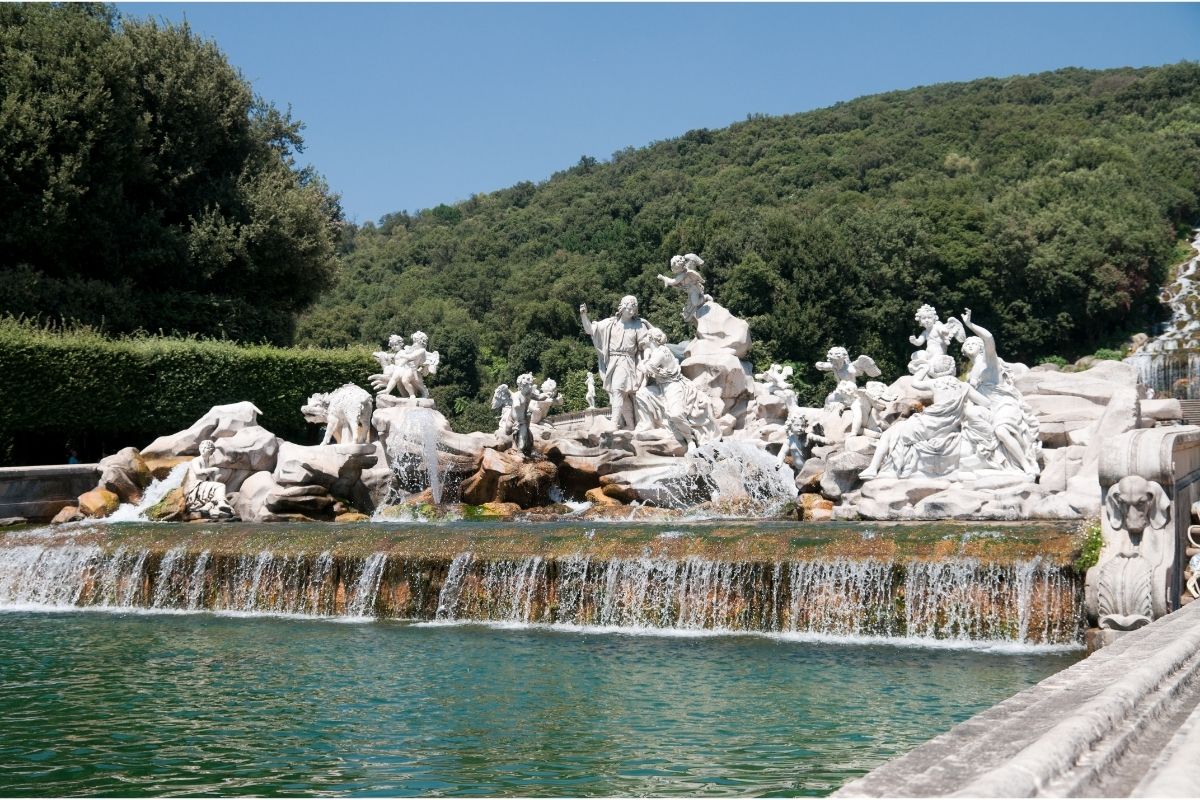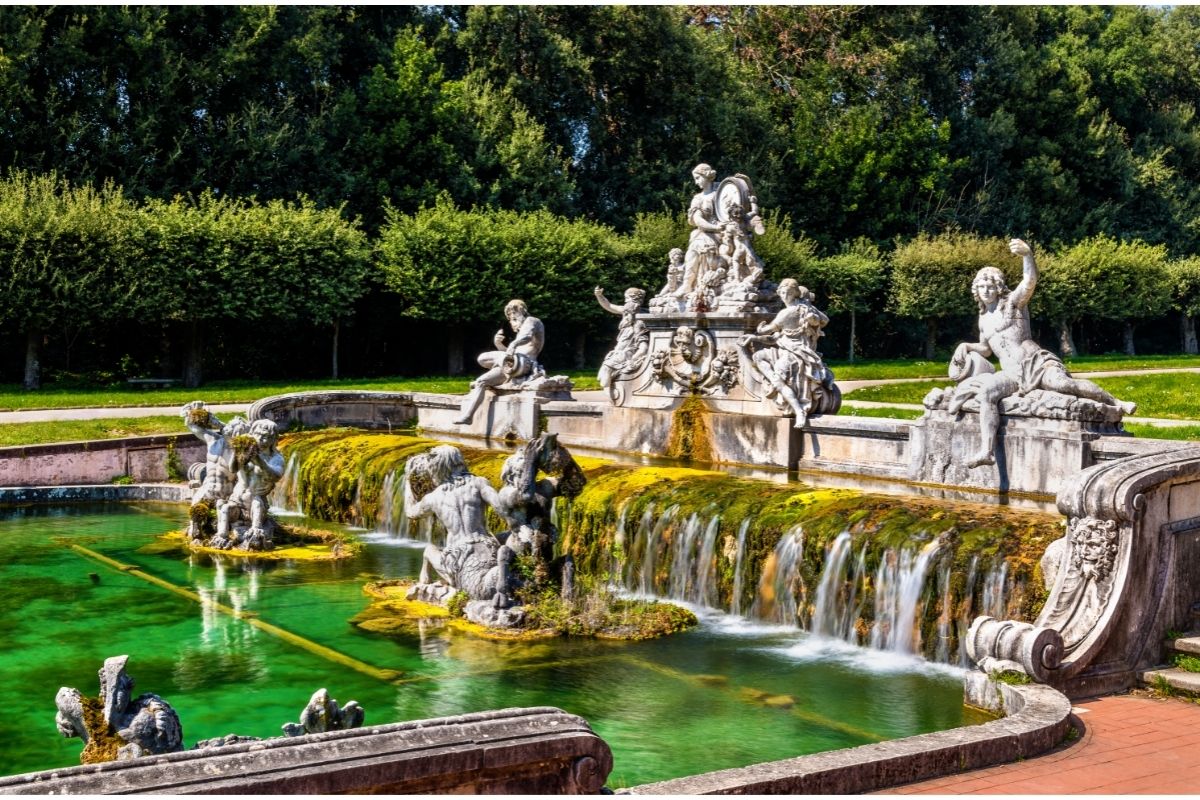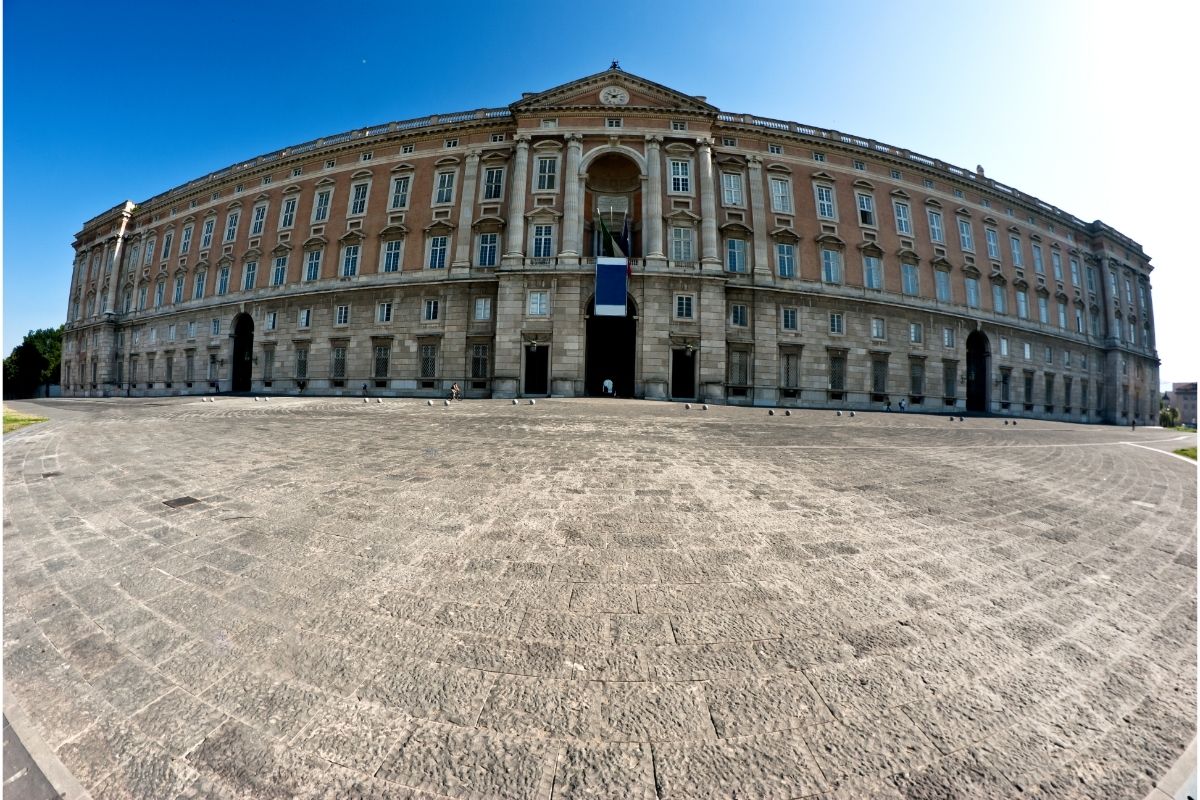The Beauty of Reggia di Caserta
Luigi Vanvitelli created The Royal Palace of Caserta and park according to the demands of Charles of Bourbon III. It is one of the greatest Italian architectures of the 18th century and combines the influences of Versailles, Rome, and Tuscany. Many people consider Caserta an Italian baroque accomplishment.
The garden’s ponds, fountains, and waterfalls span 11 ac (0.05 km squared) and are arranged in a telescope effect, extending as far as the eye can view.

The History of the Royal Palace of Caserta
The palace is in Caserta, in the Campania region of Southern Italy. The construction of The Palace of Caserta started in 1752 under Charles VIII of Naples (Charles III of Spain), with architect Luigi Vanvitelli filling Charles with emotion “fit to tear his heart from his breast.”
Charles sadly never even slept a night at the Reggia, as he surrendered in 1759 to become King of Spain.
The political and social model for the palace was versatile. It was intended to function like a little city, housing a university, museum, library, military high commands, and a hugely influential status symbol.
The palace has five floors and 1,200 rooms (including two dozen state apartments), an extensive library, a theater modeled after Teatro San Carlo of Naples, and an Italian baroque triumph. The gardens are especially famous, extending 11 ac (0.05 km squared).
The English Garden is one of Europe’s most remarkable, oldest, and most critical picturesque spaces. Buildings surrounding The Palace Caserta, such as a silk factory and associated workers’ homes, were incorporated into the design, were symbolic of enlightenment thinking, which recognized a relationship between royals and workers.
From 1923 to 1943, The Royal Palace Caserta was the location of the Accademia Aeronautica, the Italian air force academy. In 1945, the palace was the site of signing terms of the unconditional surrender of German forces in Italy.
In 1997, the palace was designated a UNESCO world heritage site, with its nomination file describing it as The Swan Song of the spectacular art of the Baroque period, from which it adopted all the features needed to create the illusions of a multi-directional space.
Italian- Recommended Attractions and Experiences on Show at the Italian Caserta Palace
There are several attractions that you can find at the Italian palace. The following are attractions that you can consider:
1. Casertavecchia— The Old Medieval Town of Caserta
Casertavecchia, the historic capital of Caserta, is a beautiful medieval village on the slopes of the Tifatini Mountains, 2.5 mi (4 km) northeast of Caserta Royal Palace. It is a very striking structure. The Norman Castle ruins, and the streets of the entire hamlet remind us of the glory of the past.
Locals frequently spend their Saturday nights strolling and socializing in the old streets, thanks to the spectacular view from many areas of the town, the cool weather, and the numerous local eateries and pizzerias. You can ask the locals about the legend of the fairies who assisted in the cathedral’s construction when you’re conversing with them!
2. San Leucio Belvedere
The Belvedere palace was the country house of the sovereigns whose best activities were hunting and participating in local rural activities. It was part of the complex of the world heritage site of 1997 along with the Royal Palace of Caserta.
The King commissioned Francesco Collecini, a Luigi Vanvitelli assistant, to enlarge the palace and transform it into a silk manufacturing center. Thus, The Royal Colony Serica of San Leucio was born in 1789, with the King issuing a specific code of laws outlining the rights and responsibilities of the villagers.
The restored silk factory’s tours, which feature sophisticated machinery, are a unique and fascinating experience.
3. Amphitheater Campano Santa Maria Capua Vetere
Santa Maria Capua Vetere is a medieval descendent of ancient Capua, one of Italy’s most important cities— famous for its many Roman masterpieces, including The Amphitheater Campano, which is only second in size to Rome’s Colosseum. Capua is the Via Appia, making it the most crucial city in the region.
The theater, museum, and underground Mithraeum, are all part of the Campania Museum complex.
4. Carditello Royal Site
In 1787, Ferdinand IV of Bourbon came up with the exquisite Carditello Royal Site to breed and select royal horses and agricultural and dairy output. Once a hunting lodge, the royal site was designed and erected for Charles of Bourbon by Roman architect Francesco Collecini, a student of Luigi Vanvitelli.
It consists of a central building, service buildings, and a vast oval gallop. Carditello was at its most abundant in the years following its construction, when court painter Jacob Philipp Hackert was charged with adorning and furnishing the royal chambers, including commissioning a ceiling painting commemorating the Bourbon Dynasty’s ascendance.
5. Capua
Capua Nuova exists on the Roman river port of Casilinum, on a bend of the Volturno River. The Roman bridge and towers of Federico II and the ruins of the Via Appia Bridge on the Volturno— represent Capua’s principal remaining Roman heritage.
The Campanus Museum, with its rich heritage of holy and profane works of art, libraries, sculptures, and architectural pieces, represents much of Capua’s rich and complicated history. The Caserta Royal Palace museum highlights Mater Matuta statues, Mommsen Lapidary, Norman-Swabian parchments, and other significant sculptures.

Experiences on Show at the Italian Caserta Palace
1. Tour the Royal Park and Gardens: The Caserta Italy park and gardens were an essential feature of the palace that architect Luigi Vanvitelli gave to the sovereigns. The park begins on the palace’s back wall, flanked by a long, straight canal with fountains and cascades. The fountains and waterfalls filling a Vasca (basin) are along a wide straight canal that stretches to the horizon, with architecture and hydraulics by Luigi Vanvitelli. You can find many sculptures of characters and theatrical scenarios from classical antiquity throughout the grounds. Of course, you can always enjoy yourself in various ways, including strolling, running, biking, and horse carriages.
2. Italy’s ‘best’ pizza: Caserta Palace Italy is said to have the “greatest” pizza in Italy, and you’re welcome to try it for yourself. Many say that Caserta is the birthplace of mozzarella, and it may now also be the birthplace of pizza. They also believe that Franco Pepe, a local cook, is the most incredible pizza chef in Italy for 2017 at Pepe in Grani (Pepper in Grains). This is due to his ability to represent the fantastic Italian Palace pizzaiola art, which in his case has its roots in the heritage of three generations of bakery masters.
3. Local food and wine: People quickly know Campania for its food and historic and medieval sites. Villa Matilde is a lovely winery, restaurant, and guest house in Cellole, near the seaside, that serves traditional food and wine in a classic countryside setting sustainably.
4. Star Wars movie locations: The Royal Palace of Caserta has served as a site for two Star Wars films. Can you visualize the universe this site inspired in a galaxy far, far away when you visit? The structures were transformed into The Royal Palace of Naboo in Star Wars: The Phantom Menace, with notable moments like carrying senators by drones down the honor staircase. In addition, there are a few brief scenes in the upper vestibule in the attack of the clones.
5. The Ballooning Festival: Every October, people converge in large numbers to witness this breathtaking display above Fragneto Monforte. The ballooning festival is Italy’s oldest and most beautiful balloon gathering. The “wind and fire” group has been organizing it since 1987. More than 25 hot air balloons from Europe take to the skies during the festival, attracting over 50,000 spectators. It is a cultural gathering as well as a sporting event. There is a diverse program of exciting arts, musical, and cultural events, exhibitions, and handicrafts in Caserta ground that you can enjoy.
6. Sannio Tattoo Festival: This enjoyable festival brings two European traditions together in a small community for a grand celebration at the end of July. This tattoo festival brings Scotland and the Sannio Region together. A group of British residents started this festival after being interested in the local beauty, food, and wine. They aimed to establish an event to blend their ancestry with local customs, allowing the two cultures to coexist. In this festival, you will find that military bands, bagpipe musicians, and Scottish and local dancers gather for The Sannio Tattoo Festival to sing and dance in a tangle of culture and song. They collaborate to create a moving event set in Sannio’s authentic Medieval village.

When is the Best Time to Visit the Royal Palace Caserta?
You can visit the palace any time of the year. The Caserta Royal Palace is open all year, although the gardens are magnificent in the spring and summer. On Tuesdays, the facility is closed. The court theater is usually available only on weekends.
Some days are also busier than others, such as the first Sunday of each month. This is because it offers free admission to the palace and a discount on park tickets. Spend a day in the Palace of Caserta to see the royal palace, the park, The English Garden, and the Terrae Motus modern art collection.
You can see hidden areas in the park and the English garden and learn about the secrets of the royal palace. Renting a bike is a terrific alternative for anyone wishing to get some exercise while exploring the grounds. The park also offers horse carriage rides and tours.
How do you get to the Royals Palace of Caserta in Italy?
The Royal Palace of Caserta is 23.6 mi (38 km) from Naples and 124.3 mi (200 km) from Rome and is easily accessible by vehicle, taxi, bus, or train. Trains run every 20 minutes from Naples Central Station. There are four Eurostar “rapid lines” every day, with trains every 30 minutes, departing from Rome Termini (railway station).
The Naples Port and Naples International Airport provide bus service every hour. A bus from Roma Fiumicino International Airport runs every two hours. A bus leaves Rome Termini every 30 minutes (railway station). All this makes it very easy for you to access the Royal Palace of Caserta any time you want.
The Appearance of the Caserta Italia in Movies
It is impressive that the Royal Palace of Caserta has been a location for many movies. Let’s look at some of these movies:
- The Great (2020)
- Caserta Palace Dream (2014)
- Angels and Demons (2009)
- L’Art des Castrats (2009)
- Mission Impossible III (2006)
- Pope John Paul II (2005)
- Luisa Sanfelice (2004)
Key Highlights
The Royal Palace of Caserta is a place that anyone worldwide would like to visit. It is beautiful, and your visit will give you an experience of a lifetime. It is easily accessible via bus, train, or any other vehicle.
Furthermore, there are many activities you can engage in while in the palace at the time of the year. It would help if you also remembered that there are days when you can visit Palace Caserta for free. So, what are you waiting for? Visit the Palace of Caserta today!

Community of passionate writers and content creators who share a love for Italian heritage, culture, travel, food, and the Italian-American community. Our mission is to celebrate Italy’s rich history and traditions and connect with others who share the same passion.

